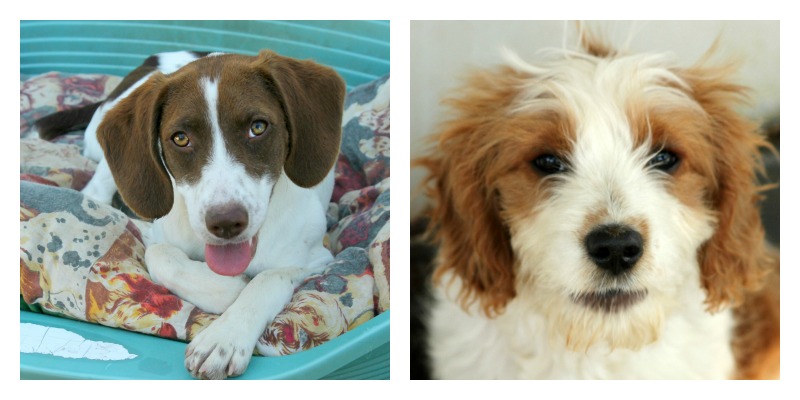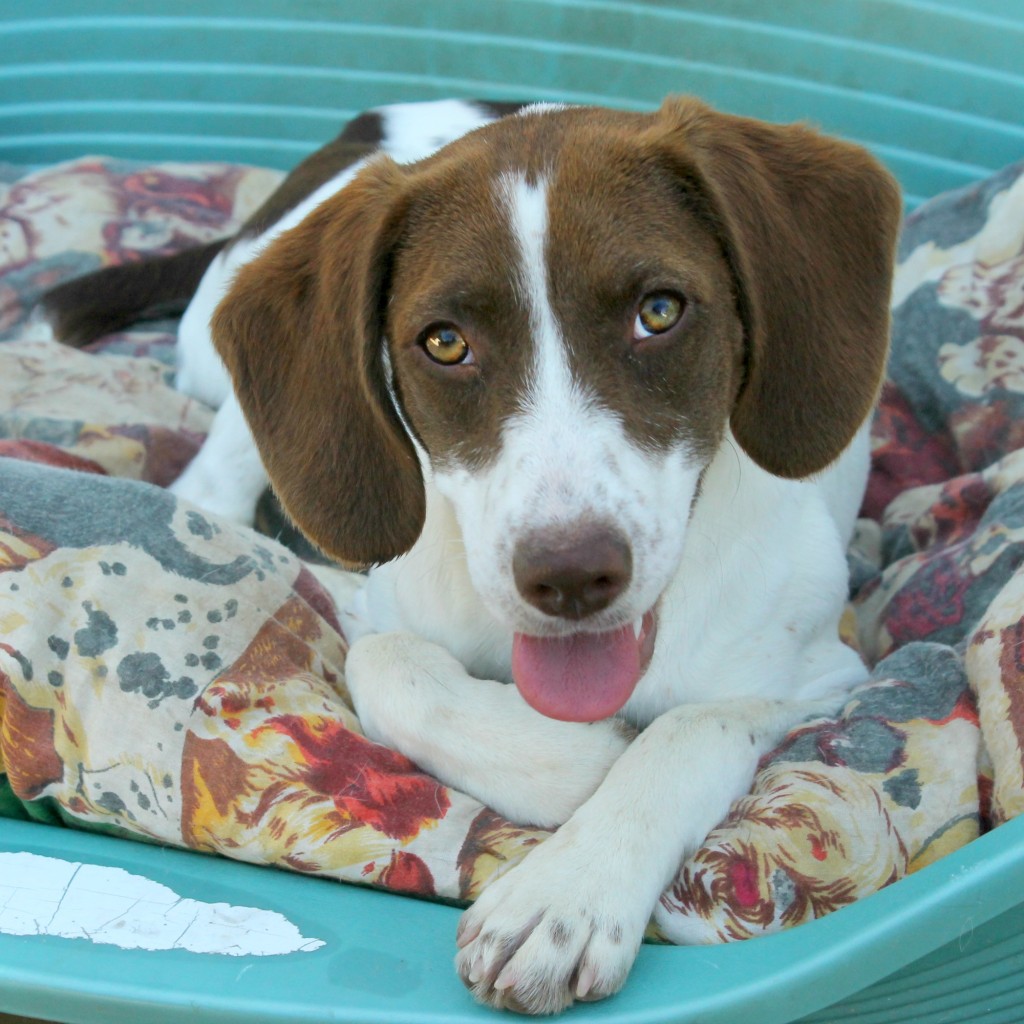Many people are surprised to learn that shelters have puppies. After all, how could such a cute little thing be abandoned so early in life?!
The truth is that many puppies at the refuge arrive mainly as the result of two things. One is the accidental breeding of a litter. The other is simple over-production. As the recession continues its stranglehold on French life, many people turn to a breeding female as a cash machine. If you don’t chip, vaccinate or have to sterilise your dogs, people think it costs nothing. This is untrue, of course, and all dogs sold or exchanged in France are legally required to be chipped. In 2016, laws will come into play to make it even more difficult to become a black market puppy breeder.
Simple common sense would suggest that the market is already flooded. Countless litters of puppies are abandoned at the refuge once they are weaned. That in itself says there’s no money in breeding, especially when many of the dogs are pedigree dogs of small sizes.
So, simply put, there are often puppies at refuges if you are really after a very young dog.
We get the older ones as well, when buyers realise that puppies take a bit of work. You have a short period of six to eight weeks in which to teach them crucial life skills which will make them impossible to live with if you do not.
The first thing we ask of all potential puppy owners is if they have the time and the patience to train a puppy. Even if you were to go to a daily puppy training class for these eight weeks, you would still need to ensure that you are available for sixteen or seventeen hours a day. A puppy is not for the faint of heart.
The second thing you need is bags of energy yourself. This is why we ask older adoptants to reconsider their choice if they want a puppy.
Puppies get in to everything!
There are many things you can do to ensure that your puppy becomes a happy, well-adjusted adult dog. Here are the top ten vital things to teach your puppy in the first six weeks. This is taken from the work of Dr Ian Dunbar, whose website Dog Star Daily needs to be your constant bible for the next couple of months. Bookmark this site as it is the definitive guide to raising a great dog. DO NOT get your puppy without having read his free guide, “Before You Get Your Puppy.” As he says, “If you have your heart set on raising and training a puppy, do make sure you train yourself beforehand.”
I would add that a small number of our adopted puppies are returned weeks, months or even a year after they are adopted, having had no training and having already developed behaviours that will make it hard to find them a home. If you take a puppy, you take an animal at the point in its life where it WILL find a home easily. If you bring it back, you have stolen that animal’s chance of being easily adopted. That’s why puppy training is serious business. Socialisation is crucial, and you can read more about why it’s so important in this article from Dr Jen.
So the ten things your puppy needs you to teach him:
- Bite inhibition. The only reason, other than palliative reasons, that the refuge will ever put a dog to sleep is if it fails four bite tests. I used to think, with my own puppy, that bite inhibition was just part of good training. Now I think it is the fundamental part of good training. That means bite inhibition with humans and with other animals. It is your job to take a little land shark and turn it into a dog who doesn’t sink its teeth into everything. For dogs, their mouths are their hands. And we know toddlers grab and touch everything. Dogs will do the same. Here is Dunbar’s post about bite inhibition. You may also find this video from Zak George helpful.
- To be used to being touched all over. In your dog’s life, someone IS going to grab him, touch his rear, pull his tail. Most likely it’ll be a child who doesn’t know any better. That’s why it’s vital your dog is desensitised to being touched all over. Regularly touch their paws, massage them, look in their mouths, their ears. Get him used to being clipped if he is a dog who will need clipping, or brushed. Dogs need desensitising to brushes and I’m sure I don’t need to remind you how hard it can be to brush children’s hair. It’s worse for dogs because children do eventually grow out of the super-sensitive stage. Dogs will just keep reinforcing the negative experience and each time will be worse. Get them used to the shower, the vet and having nails touched.
- Not to jump up. A puppy wants to be up near you and near your face so he can see what’s going on. But a 5kg puppy doing it is very different than a 30kg dog doing it. Nobody likes dogs jumping up, and for many people this can be very intimidating. The easiest way to teach your dog to stop jumping is to teach them when you want them to jump. Many people with smaller dogs bypass this step, as they do with biting, because it’s rarely as dangerous as a big dog doing it, but it is still vital.
- Sit. It’s not just a party trick. Sit is a gateway training activity. From this point, you can teach other commands such as “down” and “paw”, but you can also teach “stay”. Teach your puppy that “Sit!” means “I’m waiting for our relationship to start up and I’m excited to go!”
- Not to pee in the house. Most dogs who live in a house have to learn this one. It’s a skill we are pretty good at teaching because it’s important to us. More importantly, it’s messy if we don’t. You can find further information about house-training here. Although it is aimed at older dogs, it is as true for puppies. Remember they have small bladders and no real understanding of the messages their bladders are giving them about being full. Accidents will happen, but you need to be constantly focused to ensure your puppy has as few as possible.
- That people and other dogs are not a threat. Early socialisation is vital and you need to start after the first set of vaccinations at eight weeks. Make sure that the dogs you are interacting with have their full set of vaccinations or do not come from an environment where there is a high risk of contamination. You should ensure your dog has met a wide range of people before twelve weeks of age, including “children, men and strangers”. You can read more about that in Dunbar’s follow-up document entitled “After you get your puppy.” You also need to allow your dog to play with other dogs and learn when bites hurt, how dogs initiate and end play, how dogs socialise, what is acceptable in the dog world. A dog with great dog-on-dog bite inhibition will be much less likely to resort to teeth in a fight and will settle doggie disputes in painless ways.
- What to do when they are left alone. You absolutely must teach your puppy that being left alone is not a punishment nor any real cause for concern. You may not like to have periods when you leave your dog alone when you are together, but it is vital that your dog can occupy himself without resorting to destruction or anxious behaviours. Crate training is a crucial part of this process, but you may prefer to confine your dog to a room instead. Having the right things to chew and plenty to keep them occupied, like Kongs, and removing access to other interesting things to chew or destroy is absolutely vital here. You can teach your dog to settle and to be calm, and these are vital in ensuring you can leave your dog without anxiety.
- To walk on a lead. Puppies don’t take well to leads at first and will happily follow you all over the house, so you don’t think you’ll ever have to worry about them running off. In those first few weeks, you may even feel confident walking your dog without a lead, as puppies are like velcro. At the four month stage, the world will start to become more interesting and unless your dog has been trained to come back, and their recall is proofed, you may find it impossible to keep them from investigating the neighbourhood instead of walking to heel as they used to. Walking without pulling is easy to teach to a young puppy. It is not easy to teach to an adult dog.
- A perfect “Come!” – great recall is essential. Great recall is also very much dependent on situation, as dogs don’t generalise well. Just because they will come in the house or in the garden doesn’t mean that they will apply the same rules on a walk. Proofing those “Come!” commands is a vital factor to ensuring you can let your dog off the lead and still be in control.
- Teach him to get used to collar grabs. Whilst we may not want to ever grab our dog’s collar, it’s the situation in which 20% of bites happen. Teaching them that you touching their collar is a good thing with treats and positive reinforcement is absolutely fundamental if you want to be able to keep your dog safe.
There are many vital things to consider when adopting a puppy, which is why I said it was not for the faint of heart. All of these ten things – and more! – are vital within the first few months of a dog’s life. Following a great programme like Dr Ian Dunbar’s will help you get the best out of your dog in a force-free, positive way which will encourage your pup to make good choices rather than to obey because they are afraid. The things that our parents or grandparents might have done to train a dog, such as rubbing its nose in its urine or tapping it with a rolled-up newspaper are techniques which belong firmly in the past. The sad thing about punishments is that they are very effective at training a dog. Sadly, they do not help train a healthy or well-adjusted dog with whom you can build a trusting and confident partnership.
If you are in any doubt whatsoever, seek the advice of a qualified professional and be prepared to pay for this.


